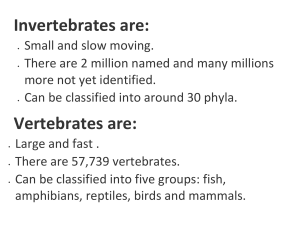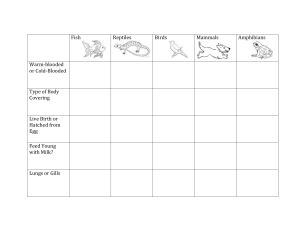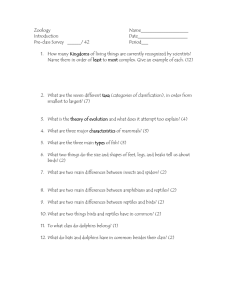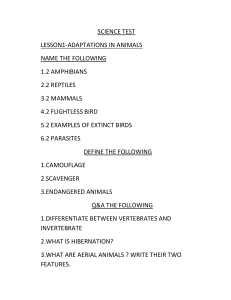Evolution: From Nebular Hypothesis to Organic Life
advertisement
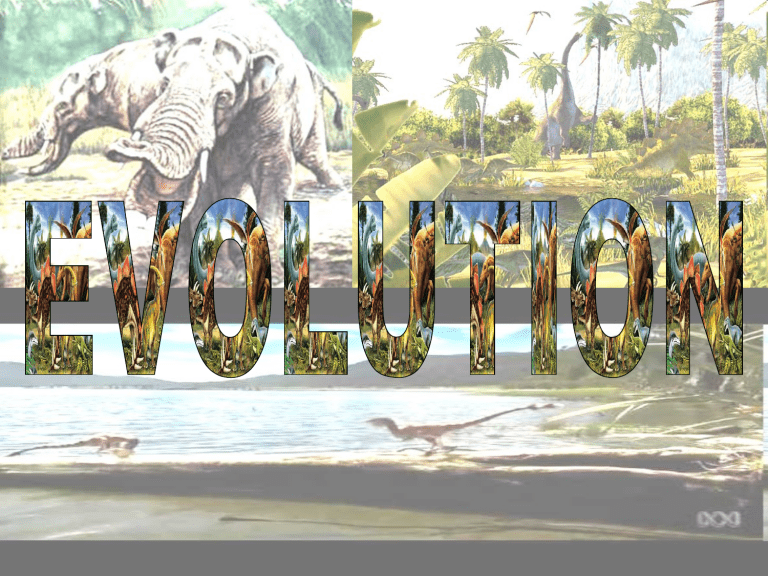
The nebular hypothesis maintains that the Solar System formed from the gravitational collapse of a fragment of a giant molecular cloud. The further collapse of the fragments led to the formation of dense cores One of these collapsing fragments (known as the pre-solar nebula) would form what became the Solar System. The earth was very hot. The energy from colliding meteorites heated the surface of the earth; compression of minerals and from the decay of radioactive materials heated the interior of the earth. Volcanoes might have frequently spewed lava and gases – relieving some pressure in Earth’s interior. Gases helped form Earths early atmosphere. Atmosphere contained no free oxygen, but water vapor, carbon dioxide and nitrogen. frequent collisions with other bodies. Eventually, the outer layer of the planet cooled to form a solid crust when water began accumulating in the atmosphere. Around 4.4 billion years ago earth cooled enough for water in the atmosphere to condense leading to millions of years of rainstorms with lightening – enough for the rain to fill depressions creating Earths oceans. STEP 1 CHEMICAL EVOLUTION STEP 2 CO2 H 2O NH3 CH4 Miller and Urey in 1953 i. Tested the Oparin-Haldane hypothesis by creating conditions in which there was an - Atmosphere above warmed sea water that contained H2O, H2, CH4, and NH3 and - Electrodes that simulated lightning. - From this setup, they obtained organic compounds such as amino acids that were collected in cooled water. The MillerUrey experiment The experiment - organic molecules could be created out of inorganic molecules. So…….why don’t we see this happening in today’s world? Any organic molecules that are now formed would be used up by living organisms. If microorganisms were created from these organic molecules in the early earth’s water bodies, this would have been an example of spontaneous creation! For much of history, man believed that living organisms could be created spontaneously from non-living material (e.g. flies from dead meat, geese from barnacles, etc.) This idea was refuted by Louis Pasteur in the 1860’s. 3. RNA was probably the first hereditary material a. Today, genetic information is usually stored as DNA, but some organisms such as viruses use RNA to store info. 2 AMINO ACIDS PROTEIN FORMATION FORMATION OF NUCLEIC ACID UNICELLULAR PLANT MULTICELLULAR PLANT UNICELLULAR ANIMAL MULTICELLULAR ANIMAL Mammals Monocots Birds Reptiles Herbs Shrubs Trees Dicots Amphibian Fish Flowering plants Mosses Insects Crustacea Mollusc Conifers Ferns Annelids Liverworts Flatworms Coelenterates Algae Fungi Multicellular plants Multicellular animals Single celled organisms Geologic Time Scale with Key Events Section 17-3 Era Cenozoic Mesozoic Paleozoic Precambrian Time Period Quaternary Tertiary Cretaceous Jurassic Triassic Permian Carboniferous Devonian Silurian Ordovician Cambrian Time (millions of years ago) 1.8–present 65–1.8 145–65 208–145 245–208 290–245 363–290 410–363 440–410 505–440 544–505 650–544 Key Events Glaciations; mammals increased; humans Mammals diversified; grasses Aquatic reptiles diversified; flowering plants; mass extinction Dinosaurs diversified; birds Dinosaurs; small mammals; cone-bearing plants Reptiles diversified; seed plants; mass extinction Reptiles; winged insects diversified; coal swamps Fishes diversified; land vertebrates (primitive amphibians) Land plants; land animals (arthropods) Aquatic arthropods; mollusks; vertebrates (jawless fishes) Marine invertebrates diversified; most animal phyla evolved Anaerobic, then photosynthetic prokaryotes; eukaryotes, then multicellular life Summary of Evolution of Life Chemical Evolution (1 billion years) Formation of the earth’s early crust and atmosphere Small organic molecules form in the seas Large organic molecules (biopolymers) form in the seas First protocells form in the seas Biological Evolution (3.7 billion years) Single-cell prokaryotes form in the seas Single-cell eukaryotes form in the seas Variety of multicellular organisms form, first in the seas and later on land EVIDENCES IN FAVOUR OF ORGANIC EVOLUTION 1. EVIDENCES FROM MORPHOLOGY AND COMPARATIVE ANATOMY 2. EVIDENCES FROM EMBRYOLOGY 3. EVIDENCES FROM PALEONTOLOGY EVIDENCES FROM MORPHOLOGY AND COMPARATIVE ANATOMY Homologous organs Organs which have similar structure and embryonic origin but are different in function are known as homologous organs and the phenomenon is called homology. This is due to their common ancestry. Homology is exhibited by every organ system of vertebrates from lowest to highest including man. The limbs of all vertebrates have a common structural plan. For example forelimbs of variety of vertebrates like whale (flippers), bat (patagia), birds (wings), horse (legs), man (hands). The forelimb of man The forelimb of man, used for handling things The forelimb of frog frog which is used for hopping The forelimb of rabbit rabbit which is used for leaping The forelimb of whale flippers of whale or seal which are used for swimming, The forelimb of bat wings of bat and bird used for flying. Though forelimbs in these vertebrates are modified for a variety of uses they are constructed on same fundamental plan. The pentadactlye plan The skeleton of forelimb of all the vertebrates contains humerus, radio-ulna, carpals, metacarpals and phalanges. The existence of homologous anatomical organ structures implies a common evolutionary origin of amphibians, reptiles, birds and mammals. Homologies Anatomical structures within Different organisms Which Originated from astructure or Trait of their Common ancestral organism. Analogous organs Certain organs which perform similar functions but are different in development and origin are called analogous organs and the phenomenon is called analogy. For example the wing of an insect, the wing of a bat and the wing of bird serve the same purpose of flying but their basic structure is totally different. The wings of bat and birds are in fact modified forms of forelegs and internally have the bones, nerves and blood vessels. While the wings of insects are membranous, made up of thin flap of chitin and supported by hollow tubes called veins. Analogous organs show the convergent evolution. This means that they evolved from different ancestry but developed similar characteristics when put in similar habitats. Analogous Structures The evolution of superficially Similar structures in unrelated organisms is called convergent evolution. Vestigial organs Vestigeal organs are those organs which are rudimentary and nonfunctional in one group of animals while same organs are well developed and functional in another group of animals. Presence of vestigial organ is a vital evidence of organic evolution. From the evolutionary point of view, vestigial organs are structures that were well- developed, functional and necessary in ancestors but are now in process of disappearance. Vestigial Structures in Man Vermiform appendix Nictitating membrane Coccyx. Ear muscles Wisdom teeth Body hair EVIDENCE FROM EMBRYOLOGY Embryology is the science that deals with the study of the development of embryo. A comparative study of embryology of different groups of animals reveals certain features which provide evidence for organic evolution. All multicellular organisms exhibit common pattern of development. Comparative study of embryological development of different vertebrate like fish, frog, lizard, chick, rabbit, human etc. shows similarity in early stages. All vertebrates begin their life history as a single celled zygote. The zygote in all organisms undergoes series of division to produce hollow ball of cells called blastula. Blastula further develops into gastrula. Gastrula in all the vertebrates has the same three primary germ layers, namely ectoderm, mesoderm and endoderm. The young ones of fishes resemble very closely to the tadpole larvae of amphibians. This shows the origin of amphibians from fish-like ancestors. The embryos of all the vertebrates at one stage or the other possess pharyngeal gill slits, slits two chambered heart, tail etc. Even human embryo at eight weeks develops the gill slits and tail. But as the development proceeds, gill clefts persist only in fishes and get closed in other vertebrates. The heart remains two chambered as in adult fish, but it becomes three chambered in amphibians and most reptiles and four chambered in crocodiles, birds and mammals. Comparative Study Of Heart The fish have a linear heart (sinus venosus, atrium, ventricle and conus arteriosus, in that order input and output) The heart of amphibians is modified from the heart of the fish, which was a linear heart (sinus venosus, atrium, ventricle and conus arteriosus, in that order entry and exit). The structure of the heart of amphibians is highly variable and has been modified into a three-chambered heart with two receptacles, and one exit. In reptiles, changes occurred in the transition environment, an aquatic to land. The development of this movement involves changes in the structure of the heart to adapt to new habitats. Reptiles has three chambers, two atria (right and left) and a ventricle. The ventricle is incompletely subdivided into two chambers. The circulatory system of birds is composed of a heart and a complex system of veins and arteries. The major evolutionary advance that arise regarding their relatives the reptiles is that the heart has four chambers, two atria and two ventricles. Basically the operation of the mammalian heart is almost the same as birds. Their hearts are divided into four compartments, two atria and two ventricles. Comparative Study Of Heart EVIDENCES FROM PALAEONTOLOGY Palaeontology deals with the study of fossils. What are fossils? Usually plants and animals after death are decomposed by bacteria. But sometimes they are preserved as fossils. Fossils are any form of preserved remains or traces, thought to be derived from living organisms. They provide concrete proof to the fact that variety of animals and plants had lived in various geological ages of earth. Examples of fossils Dinosaurs: They existed on earth some 200 million years ago in the Jurassic and Triassic periods. The dinosaurs known as Tyrannosaurs were the largest living carnivore ever. It stood 20ft tall and was about 50 ft in length. It had dagger like teeth measuring about six inches. Archaeopteryx: Commonly known as reptile-bird, was a primitive bird-like form. Its fossil was found in Germany in the rocks of Jurassic period, of about 150 million years ago. It was about the size of a crow and represented both the characters of birds and reptiles. Archaeopteryx: characters of birds and reptiles Like birds it had wings with feathers but, wings had clawed digits like in reptiles. It also had beak like in birds. But, beaks had conical teeth like in reptiles. It had feathery tail like in birds. But, Tail was long like lizards and had tail vertebrae. Body was covered with feathers like in birds but also had scales like in reptiles. It skeletal framework resembled more with reptiles than the birds. It is probable that it used its forelimb for flying as well as climbing. Thus, Archaeopteryx provides a connecting link between reptile and birds. Evolution of horse: The history of evolution dates back some 60 m.y.a. in Eocene epoch and involves about 20 genera. The phylogeny of horse starts with Eohippus, a small fox like creature with longer head. It had shorter legs with four toes on each front foot and three on each hind foot. It was a forest dweller, feeding upon soft vegetations. It passed through evolutionary line to give rise to modern day horse. Genera Epoch 1.Eohippus 2.Mesohiuppus 3.Merychippus 4.Pliohippus 5.Equus (modern day horse) Eocene Oligocene Miocene Pliocene Pleistocene Major changes seen in modern horse are: •Enlargement and elongation of third digit •Loss of other digits •Elongation of fore part of skull •Lengthening of limbs •Increase in the length and mobility of neck •Development of premolars and molars into high crowned •Increase in body size Evolution of horse The Law of Use and Disuse • He proposed that if an organ is used a lot it will develop and strengthen • If it is not used it will atrophy • He called this the law of use and disuse © 2008 Paul Billiet ODWS The Inheritance of Acquired Characteristics • if an organism developed a characteristic feature through adapting to a new way of life during its lifetime, it would pass this on to its offspring • The classic example given is that of the giraffe’s neck • As the giraffe’s ancestors searched for a richer food supply they stretched to reach higher branches in trees • Thus their stretched bodies were passed onto their offspring © 2008 Paul Billiet ODWS Natural Selection • There is variation in all species • Some variation better adapted for the environment than others • Natural selection (survival of the fitter): Individuals with characteristics better adapted for the environment will survive and have more viable offspring than non adapted individuals. Lamarck’s evidence and inference • Comparisons between current species and fossils: lines of descendents • Use and disuse • Inheritance of acquired characteristics What exactly is a theory? • Explain which picture describes Lamarck’s view and which pictures describes Darwin’s view. 16 claws wing-like forelimbs teeth thin ribs long tail feathers Replica of Archaeopteryx fossil; half bird half reptile © Alan Richardson Reptile-like features Bird-like features Geologic Time Scale with Key Section 17-3 Events Era Cenozoic Mesozoic Paleozoic Precambrian Time Period Quaternary Tertiary Cretaceous Jurassic Triassic Permian Carboniferous Devonian Silurian Ordovician Cambrian Time (millions of years ago) 1.8–present 65–1.8 145–65 208–145 245–208 290–245 363–290 410–363 440–410 505–440 544–505 650–544 Key Events Glaciations; mammals increased; humans Mammals diversified; grasses Aquatic reptiles diversified; flowering plants; mass extinction Dinosaurs diversified; birds Dinosaurs; small mammals; cone-bearing plants Reptiles diversified; seed plants; mass extinction Reptiles; winged insects diversified; coal swamps Fishes diversified; land vertebrates (primitive amphibians) Land plants; land animals (arthropods) Aquatic arthropods; mollusks; vertebrates (jawless fishes) Marine invertebrates diversified; most animal phyla evolved Anaerobic, then photosynthetic prokaryotes; eukaryotes, then multicellular life

